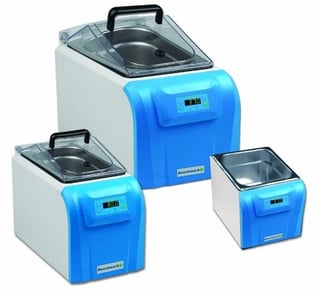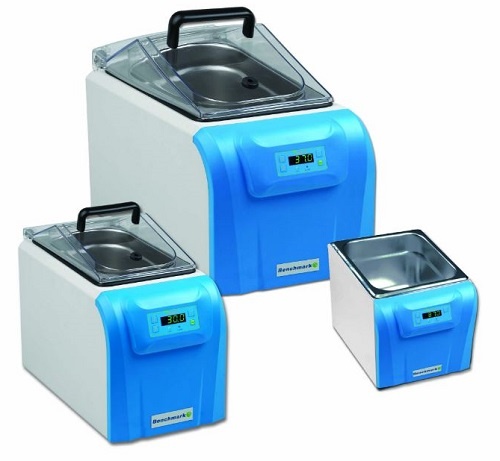In general, heated dry baths and water baths are similar in their function which can make choosing between them difficult. That said, each has its own strengths and weaknesses that makes them best suited for specific tasks. When choosing which one is right for you, it’s useful to consider these points:
1. How clean do you need your working environment to be?
In general water baths are prone to contamination. They are large pools of water that are sitting at 37 ˚C all day. Even when properly cared for and cleaned regularly they can become a source of contamination. This makes them poorly suited for aseptic use like thawing tissue culture reagents. Contaminated water is also swimming in RNAases which makes water baths bad choices for RNA work.

Dry baths offer superior hygiene. Most have a removable machined metal blocks that can easily be autoclaved. The lack of liquid also makes it more difficult to spread contamination between the block surfaces and the sample container. This makes dry baths better suited for areas where aseptic conditions are necessary.
2. What size and shape are the containers that you are trying to heat?
Water baths are best suited for large and oddly shaped objects. You can heat anything that fits in them. This makes them suitable for use with almost any sample container from small PCR tubes to irregularly shaped objects like specimens frozen in a bag. On the downside whatever you put in the water must be sealed, which means no open containers like PCR plates or test tubes. Since water baths work with almost anything they are less expensive to own. If you can only afford one piece of equipment for thawing samples, a water bath may be right for you.
Dry baths are best suited for specific containers, think 1.5 mL or 15 mL conical tubes. They usually come with machined metal blocks that are specifically made for one type of container. This one fits 13 mm test tubes. This one fits 96 well PCR plates. This one fits 50 mL conical centrifuge tubes. Specialized heating blocks are a double-edged sword. On one hand they are standardized which makes them efficient and easy to work with. While on the other hand, you need a block for each type of container you use, which makes owning them more expensive. These blocks are typically small too, so you can’t do something like defrost a 1 L bottle.
3. How fast do I need to heat my samples?
Water baths supply much more heat to a sample. This is because they offer a better contact surface area for heat transfer. This means your samples will heat faster and more evenly which is good for reproducibility. The large amount of stored heat in a bath also resists temperature fluctuations better, meaning you can heat more samples at once. On the downside, the high heat capacity also makes the startup time for a water bath much longer (up to many hours depending on the temperature set and the bath size), which makes them much less convenient. Many labs keep them on 24/7 to avoid this start up time, which can be expensive. Even small baths like this 6L one from Labnet use 550 a watt heating element, so power draw is something to consider over the long run.
Metal dry bath blocks don’t store as much heat as water does which means samples take longer to bring to temperature. Less stored heat also makes dry baths less able to resist temperature fluctuations. This can be bad if you are trying to heat several samples at once. As heat blocks can’t physically circulate heat like water can, they are also less uniform in their temperature. Newer models like this one from Benchmark mitigate this by using a cover to insulate the block. Some models like this one also from Benchmark, have heated lids to improve temperature uniformity and eliminate condensation. On the upside heat blocks are usually smaller so they heat up much faster than a water bath. Most are ready to use in around 15-30 minutes.
If you are looking for water baths check these out:
Benchmark myBath Digital Water Baths – Standard water bath.
Labnet Mini Water Bath - Standard water bath.
Benchmark Shaking Water Bath – Orbital shaker and bath!
If you are looking for a dry bath give these a try:
Benchmark Digital DryBaths Standard dry bath.
Labnet Dry Baths - Standard dry bath.
Benchmark myBlock Dry Bath with Heated Lid – No more condensation!
Benchmark myBlock Mini DryBath – Fits in the palm of your hand.
Benchmark IsoBlock Dry Bath- Double the fun!



